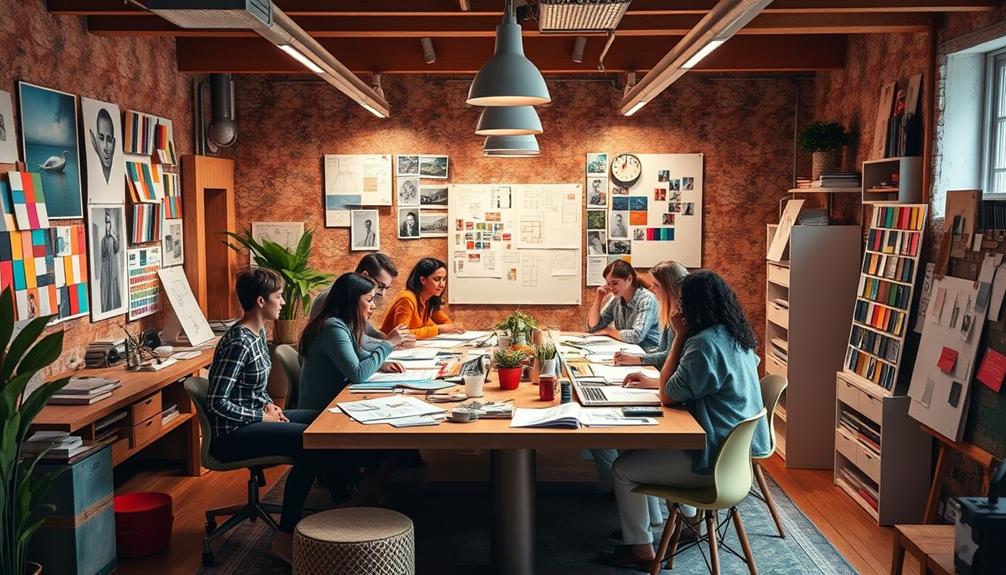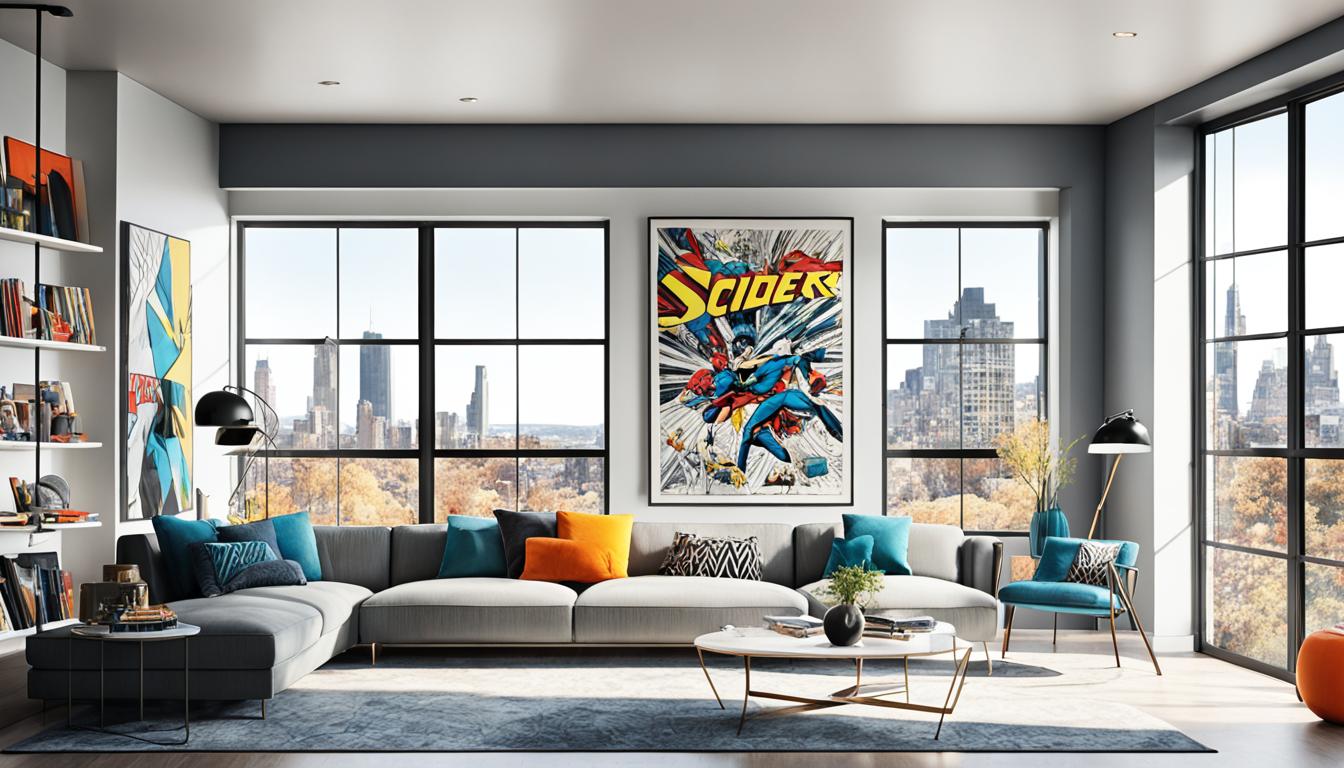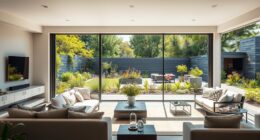Running an interior design business starts with a clear vision and strategy that guides your decisions. You need to understand your clients' needs through consultations and active listening. Develop diverse service offerings while ensuring you manage your finances meticulously with a budget and cash reserve. Marketing plays a vital role, so build a professional website and utilize social media to showcase your projects. Assemble a talented team that aligns with your brand values, and prioritize client relationships for repeating business. By focusing on these key areas, you can create a thriving interior design firm. There's plenty more to explore on optimizing your business. When it comes to naming your interior design business, it’s important to choose a name that reflects your brand identity and resonates with your target market. Consider the message you want to convey and how you want to position your business in the industry. A memorable and unique name can set you apart from the competition and leave a lasting impression on potential clients. Take the time to brainstorm and research potential names to ensure that you find the perfect fit for your interior design business.
Key Takeaways
- Establish a clear business vision and strategy to guide decision-making and align team efforts toward common goals.
- Conduct thorough consultations to understand client needs and preferences, ensuring personalized design solutions.
- Develop a diverse range of service offerings, clearly defining deliverables to meet varying client budgets and expectations.
- Implement disciplined financial planning by maintaining detailed records, budgeting effectively, and reviewing financial performance regularly.
- Utilize effective marketing strategies, including a professional website and social media engagement, to showcase projects and attract clients.
Defining Your Business Vision
Defining your business vision is like setting the foundation for a sturdy building; it gives your interior design venture direction and purpose. A clear vision not only guides your decision-making processes but also aligns your team's efforts toward common goals, establishing a strong brand identity.
When crafting your vision, think about your unique design approach and the specific problems you aim to solve for potential clients. This focus enhances your market positioning and makes your business stand out.
Learning from successful industry examples can inform your vision, allowing you to adopt best practices that resonate with your target audience. A well-articulated vision statement serves as a motivational tool, inspiring both your team and potential clients by expressing your passion and commitment to enhancing spaces.
Don't forget to regularly revisit and refine your business vision. This guarantees it remains relevant and adaptable to changing market trends and client needs.
Understanding Client Needs

A strong business vision lays the groundwork for understanding client needs, which is vital for your interior design success. To effectively tailor your design services, you need to gather detailed information about your clients. Here are three strategies to help you understand their preferences and needs:
1. Conduct Initial Consultations: Use these meetings to dive deep into clients' lifestyles, preferences, and specific design goals. This helps you create personalized solutions.
You might also consider how understanding their cleaning habits can inform design choices that enhance functionality and aesthetics, such as integrating Key Factors in Choosing a Home Cleaning Service into the design process.
2. Utilize Questionnaires or Surveys: These tools can uncover demographics like age, family size, and design style preferences. The data you gather enhances your understanding of what clients are truly looking for.
3. Engage in Active Listening: Pay attention during discussions to identify underlying psychological needs or challenges. This insight can lead to more effective and meaningful designs.
Incorporating client feedback throughout your projects is essential. After project completion, establish a feedback loop to assess satisfaction levels and gather insights for continuous improvement.
Developing Service Offerings

When developing your service offerings, start by defining the specific scope of each service, like full-service interior design or e-design.
This clarity helps you articulate your unique value proposition to potential clients and sets the foundation for their expectations.
Defining Service Scope
Successful interior design businesses thrive on well-defined service scopes that meet diverse client needs. By clearly outlining the services you'll offer, you set the foundation for client expectations and project success.
Consider the following elements when defining your service scope:
- Specific Services: Identify key areas like kitchen design, bathroom renovations, and e-design offerings. Tailoring your services to various client preferences guarantees you cater to a wider audience.
- Deliverables: For each service package, create a list of deliverables. This could include mood boards, paint palettes, and furniture selections. Clarity on what clients can expect builds trust and satisfaction.
- Service Differentiation: Distinguish between full-service interior design and e-design offerings. This approach accommodates different budgets and expectations, making your services more accessible.
Additionally, establish limitations within your offerings to prevent overcommitment.
Regularly assess and adjust these services based on market trends and client feedback to keep your business competitive and relevant.
Unique Value Proposition
In the competitive world of interior design, your unique value proposition (UVP) sets you apart by clearly defining how your services address specific client needs.
Focus on what makes your interior design business different, whether it's expertise in sustainable design or a knack for vintage aesthetics. Tailoring service offerings to meet the psychological needs of your target audience can greatly enhance client engagement. For instance, personalized consultations for busy professionals can position your services as uniquely valuable. Offering specialized options like best window treatments or unique DIY projects can further diversify your service portfolio.
Consider developing distinct service packages like full-service design, e-design, and hourly consultations. This allows clients to select options that fit their budget and project scope, reducing confusion and increasing satisfaction.
Highlight key deliverables in your service descriptions, such as customized mood boards, 3D renderings, or space planning diagrams. These tangible benefits reinforce your UVP and demonstrate the value you provide.
Additionally, regularly assess client feedback and market trends to refine your offerings. Staying relevant and appealing to your target demographic not only strengthens your UVP but also drives more business.
Financial Planning Essentials

When you're starting your interior design business, effective financial planning is essential.
You'll need to budget for startup costs, establish clear payment structures, and track your expenses and revenue carefully.
Budgeting for Startup Costs
Establishing a well-thought-out budget is essential for launching your interior design business. You need to take into account various essential startup costs to guarantee a strong foundation.
Here's a quick overview of what to include:
- Website Development: Allocate about $250 per year for a professional website to showcase your portfolio.
- Software: Invest in design and accounting software to streamline your workflow and finances.
- Marketing Expenses: Set aside funds for initial marketing to attract your first clients.
Additionally, maintaining a cash reserve of at least six months' worth of operating expenses will help you navigate the early stages when income may be delayed.
Don't forget to plan for other costs like insurance, licensing fees, and legal assistance.
Implementing a clear payment schedule can aid in cash flow management. Take into account a structure of 50% upfront, 35% at three-quarters completion, and the remaining balance before project delivery.
Payment Structures and Policies
Having a solid budgeting strategy sets the stage for effective payment structures and policies in your interior design business. To maintain healthy cash flow, implement a payment schedule that typically includes 50% upfront, 35% at three-quarters completion, and the final balance before project delivery. This approach guarantees you have funds available throughout the project lifecycle, much like understanding the specific needs of different dog breeds, including dog health and nutrition.
Establish clear payment policies to outline late fees, refund conditions, and accepted payment methods. This clarity helps avoid misunderstandings and guarantees client compliance.
Consider using reliable payment processors like Stripe or PayPal to facilitate secure transactions and streamline client payments, which enhances the overall client experience.
Regularly review and adjust your pricing structure based on project complexity, market rates, and operational costs. This practice keeps you competitive and profitable in the industry.
Additionally, keep meticulous records of all financial transactions and client payments using accounting software. This not only aids in budgeting but also provides valuable insights for future financial planning.
Tracking Expenses and Revenue
To effectively manage your interior design business, tracking expenses and revenue is essential from the very start. Implementing robust accounting software can streamline this process, giving you accurate insights into your financial performance and cash flow.
Here are three key strategies to evaluate:
- Maintain Detailed Records: Keep a thorough record of all project expenses, including materials, labor, and overhead. This helps you assess profitability on a per-project basis and adjust your pricing strategies accordingly.
- Establish a Budget: Create a budget that aligns with your projected income and expenses. This not only fosters financial discipline but also prevents overspending, which is vital for long-term sustainability.
- Review Financial Performance Regularly: Make it a habit to review your financial performance monthly. This allows you to spot trends in your revenues and expenditures, enabling timely adjustments to enhance profitability.
Effective Marketing Strategies

In today's competitive landscape, effectively marketing your interior design business is essential for attracting clients and building a strong reputation. Start by establishing a professional website optimized for SEO. Include high-quality images of your portfolio and client testimonials to enhance visibility and draw in potential clients.
Additionally, consider sharing crazy games that can engage clients during design consultations or events, making the experience enjoyable and memorable.
Utilize social media platforms like Instagram and Pinterest to showcase your design projects. These visual mediums greatly increase engagement and help you reach a broader audience.
Incorporating content marketing strategies is also key; create informative blog posts about design trends, tips, and case studies. This not only improves your search engine rankings but also positions you as an industry expert.
Don't forget to build relationships with suppliers and attend industry events, networking opportunities, and local trade shows. These connections can lead to valuable referrals vital for client acquisition in the competitive interior design market.
Building a Strong Team

A strong team can elevate your interior design business, driving creativity and efficiency while allowing you to focus on your vision. To build this team, consider the following strategies:
- Hire for Alignment: Seek individuals who share your brand values and possess complementary skills. This enhances overall team effectiveness, ensuring everyone contributes meaningfully. Engaging with networks of professionals can also provide insights into potential hires, making it easier to find the right fit for your team opportunities to stay informed.
- Foster Inclusivity: Emphasizing inclusivity and fair compensation attracts top talent, creating a supportive work environment that boosts team satisfaction and retention.
- Establish Communication Channels: Clear communication channels and regular check-ins prevent misunderstandings and strengthen collaboration. This is essential for effective project management, allowing everyone to stay on the same page.
Additionally, delegate tasks according to team strengths to boost morale and efficiency. When team members feel valued for their contributions, productivity soars.
Don't forget to build relationships with skilled freelancers or contractors. They provide flexibility and expertise for specialized projects, ensuring high-quality results while helping you manage workload fluctuations.
Managing Client Relationships

Strong client relationships are the backbone of a successful interior design business. To build and maintain these relationships, start by establishing clear communication channels from the outset. This helps manage expectations and aligns everyone on project goals, timelines, and budgets. Detailed contracts are essential too; they outline project scope, deliverables, and payment terms to prevent misunderstandings.
Schedule regular check-ins and updates throughout the project to maintain transparency and foster trust. By personalizing your client interactions, you can better understand their preferences and needs, which enhances satisfaction and encourages loyalty. Following up after project completion is equally important. This allows you to gather feedback, address any concerns, and reinforce relationships for potential repeat business.
Here's a quick reference table to guide you in managing client relationships:
| Action | Purpose | Outcome |
|---|---|---|
| Clear Communication | Align on project goals | Minimized misunderstandings |
| Detailed Contracts | Outline responsibilities | Clear expectations |
| Regular Updates | Maintain transparency | Foster trust |
| Personal Interactions | Understand client needs | Enhanced satisfaction |
| Post-Project Follow-up | Gather feedback | Strengthened relationships |
Ensuring Continuous Improvement

Building solid client relationships lays the groundwork for continuous improvement in your interior design business.
To guarantee you're always evolving, focus on gathering client feedback and adapting your strategies accordingly. Here are three key steps to implement:
1. Solicit Regular Feedback: Use surveys or follow-up calls to understand how your clients feel about your service offerings.
This insight can highlight areas needing improvement and boost client satisfaction.
2. Invest in Professional Development: Attend industry workshops, webinars, and conferences to stay updated on market trends.
This ongoing learning fosters creativity and keeps your designs fresh and relevant.
3. Evaluate Project Outcomes: Establish a structured system for reviewing project success, including financial performance and client feedback.
This evaluation will help you identify effective strategies and areas for adjustment.
Conclusion
Running an interior design business isn't just about creativity; it's also about strategy and connection. You'll find that successful designers don't just have an eye for aesthetics; they understand their clients' needs and adapt to market trends. By continuously improving your skills and services, you'll not only meet but exceed client expectations. Remember, the best designs come from a blend of vision and collaboration, proving that great design is truly a team effort.








